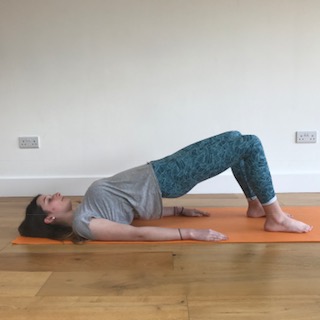Bridge Pose — Setu Bandha Sarvangasana (SAY-too BAHN-duh shar-vahn-GAHS-uh-na) — is a beginning backbend that helps to open the chest and stretch the thighs. When you’re in the pose, your arms and legs create a “locked bridge” with your body. This pose can be used as preparation for deeper backbends or practiced with a block as a restorative pose.
Bridge Pose opens the chest, heart, and shoulders. It stretches the spine, the back of the neck, the thighs, and the hip flexors (front hip joints). Because your heart is higher than your head in this pose, it is considered a mild inversion (less strenuous than other inversions, such as Headstand) and holds all the benefits of inversions: Relief from stress, fatigue, anxiety, headaches, insomnia, and mild depression.
Bridge Pose also calms the mind and is known to be therapeutic for individuals with high blood pressure. Because it opens the chest, it increases lung capacity, which is therapeutic for those with asthma.
Bridge Pose also stimulates the abdominal organs and thyroid glands, which improves digestion and helps to regulate metabolism. Because it revitalizes the legs and stretches the shoulders, it can be a particularly rejuvenating pose for those who spend the day sitting in front of a computer or driving.
Do not perform this pose if you have a neck or shoulder injury. Always work within your own range of limits and abilities. If you have any medical concerns, talk with your doctor before practicing yoga.
Instructions
- Lie on your back with your knees bent and feet on the floor. Extend your arms along the floor, palms flat.
- Press your feet and arms firmly into the floor. Exhale as you lift your hips toward the ceiling.
- Draw your tailbone toward your pubic bone, holding your buttocks off the floor. Do not squeeze your glutes or flex your buttocks.
- Roll your shoulders back and underneath your body. Clasp your hands and extend your arms along the floor beneath your pelvis. Straighten your arms as much as possible, pressing your forearms into the mat. Reach your knuckles toward your heels.
- Keep your thighs and feet parallel — do not roll to the outer edges of your feet or let your knees drop together. Press your weight evenly across all four corners of both feet. Lengthen your tailbone toward the backs of your knees.
- Hold for up to one minute. To release, unclasp your hands and place them palms-down alongside your body. Exhale as you slowly roll your spine along the floor, vertebra by vertebra. Allow your knees to drop together.
If you’re having trouble keeping your hips lifted or to create a restorative version of the pose, place a block or bolster under your sacrum — the spot on your lower back directly above your tailbone — to support your pelvis. Allow your weight to rest on the block.
If your shoulders are very tight, keep your hands alongside the body with your palms pressing into the mat rather than clasping your hands beneath your torso.
When you are in the full version of the pose, do not force your shoulders away from your ears by tugging too hard or turn your head to the right or left when you’re in the pose. Doing so can cause neck injury.
Keep your shoulder blades drawn together as you extend your arms beneath your torso.
To find out more about Yoga at the Studio Durham House Farnham, click here


